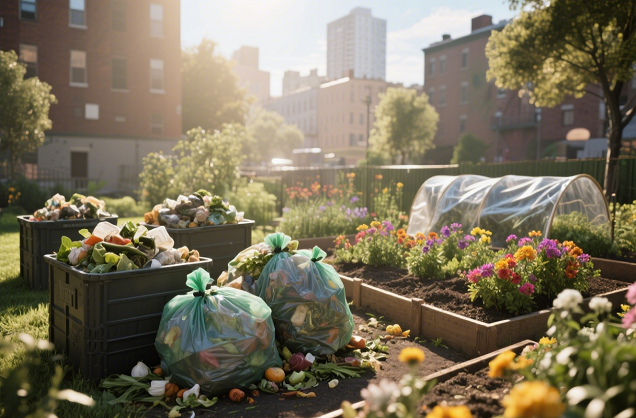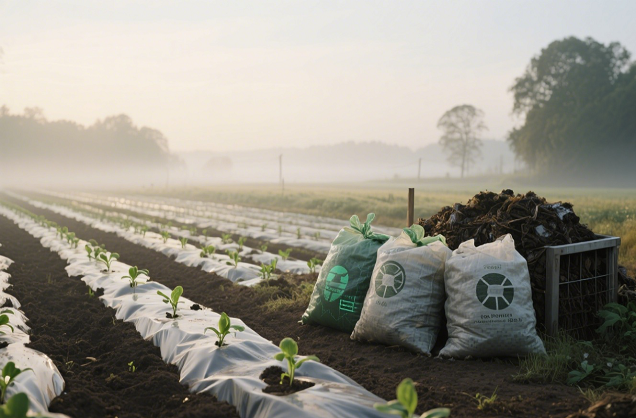The Ultimate Guide to Home Composting in 2024: Easily Reduce Food Waste by 90% with These 3 Compostable Bags
Why is home composting so important?
According to the U.S. Environmental Protection Agency (EPA), food waste accounts for 24 percent of municipal solid waste, much of which ends up in landfills, producing large amounts of methane - a greenhouse gas 25 times more potent than carbon dioxide. Home composting not only reduces the amount of waste going into landfills, it also converts organic waste into nutrient-rich fertilizer that provides natural nutrients for gardens and plants. In this article, we will introduce 3 efficient compostable bags that will help you easily reduce your food waste by 90%.

Part I: Home Composting Basics
1. Four Golden Materials for Composting
- Green materials (nitrogen source): fruit peels, vegetable scraps, coffee grounds, tea bags
- Brown materials (carbon source): dried leaves, cardboard, newspaper, wood chips
- Materials to avoid: Meat, dairy, grease, pet waste (may carry pathogens)
2. 3 Mainstream ways to compost
- Backyard compost bins: good for homes with outdoor space, low cost but need to be turned regularly
- Vermicomposting (worm composting): suitable for indoor, high efficiency but need to manage worm environment
- Electric composter: fast decomposition (24-48 hours), but higher equipment costs

Part 2: 3 Revolutionary Compostable Bags Recommended (2024 Update)
1. BioBag 3 Gallon Compostable Bags (Best All Around Choice)
Material: made of corn starch, vegetable oil polyester, meets ASTM D6400 standards
Benefits:
Completely breaks down in just 10-12 weeks
Highly tear-resistant, holds up to 10 lbs
Plasticizer-free, suitable for direct Compatible with vermicomposting systems
Scenarios: Kitchen food waste collection buckets, backyard compost bin liners
2. UNNI 100% Compostable Bags (Cost Effective Choice)
Material: PBAT + PLA biodegradable materials, OK Compost HOME certified
Benefits:
15%-20% less expensive than similar products
Ventilated holes to minimize odor buildup
Completely decomposes in a home composting environment (no need to compost) Can be completely decomposed in a home composting environment (no industrial facility required)
Actual data: no leakage after hanging for 5 days after filling up with food waste
3. Full Circle Fresh Air Compost Bin Liners (High-end deodorizing model)
Core technology: bamboo charcoal layer is added to adsorb ammonia and hydrogen sulfide
Exclusive Advantage:
Bacteria inhibition rate of 99% (third party test report)
Patented mesh structure accelerates oxygen flow and reduces mold and mildew. Patented grid structure accelerates oxygen circulation and reduces mold
Winner of the 2024 Green Household Product Gold Award
User feedback: suitable for odor-sensitive households, especially for apartment composting

Part III: Frequently Asked Questions
Q: Do compostable bags attract mosquitoes?
A: Choose a product with a seal (such as Full Circle) and be sure to empty it weekly. Add coffee grounds to repel fruit flies.
Q: How do I compost in the winter?
A: Move compost bins to the garage or use an insulated cover. Vermicomposting needs to be kept above 15°C.
Q: How can I tell the compost is finished?
A: The finished product should be dark brown, fluffy and earthy. Undecomposed residue can be filtered through a sieve.

 Significant progress in PBAT/s
Significant progress in PBAT/s
 PLA/PBAT composite film degrad
PLA/PBAT composite film degrad
 A New Choice for Takeaway Pack
A New Choice for Takeaway Pack
 Significant progress in PBAT+s
Significant progress in PBAT+s
CONTACT
Add: Room 4006, No.1 Helong Yiheng Road, Baiyun District, Guangzhou City
Tel: +8613450255948
Wechat : +86-13450255948
Fax: +86-13450255948
E-mail: 13450255948@163.com








